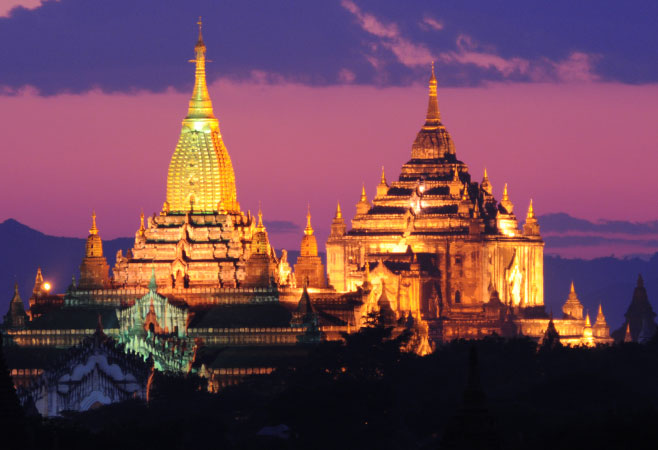Bagan Temple And Pagoda History.

Bagan’s temples and pagodas date back to the 9th to 13th centuries during the Bagan Empire’s reign in Myanmar. Over 2,000 structures remain, showcasing ancient Burmese architecture.
Bagan, located in Myanmar, is an archaeological wonder. The city’s skyline is dotted with thousands of temples and pagodas. These structures, built between the 9th and 13th centuries, reflect the height of the Bagan Empire’s prosperity. Each temple and pagoda tells a unique story, embodying the rich cultural and religious history of the region.
Visitors can explore these ancient monuments, marvel at their intricate designs, and learn about the Buddhist traditions that inspired their construction. Bagan remains a must-visit destination for history enthusiasts and spiritual seekers alike.

Credit: en.wikipedia.org
Ancient Beginnings
Bagan, a city in Myanmar, is rich with ancient history. The temples and pagodas tell stories of a glorious past. This section delves into the early days of Bagan’s history.
Early Settlements
Early settlers chose Bagan due to its fertile land. The Irrawaddy River provided water for farming. These settlers built small villages along the river.
- Fertile land for agriculture
- Access to the Irrawaddy River
- Formation of small villages
These villages grew into larger communities. They built the first simple temples and pagodas. These structures were places of worship and gathering.
Origins Of Bagan
The origins of Bagan date back to the 9th century. A king named Anawrahta founded the city. He unified the region and built many temples.
| Key Figure | Contribution |
|---|---|
| Anawrahta | Founded Bagan and built many temples |
Anawrahta was a powerful leader. He promoted Theravada Buddhism in Bagan. This led to the construction of many religious sites.
- Unification of the region
- Promotion of Theravada Buddhism
- Construction of temples and pagodas
These early temples were made of wood. Later, they used brick and stone. This change helped preserve the structures for centuries.
Bagan soon became a center of learning and culture. Monks and scholars from around the world visited Bagan. They shared knowledge and contributed to its rich history.
Golden Age Of Bagan
The Golden Age of Bagan, from the 11th to 13th centuries, marks an era of prosperity and cultural richness in Myanmar. During this period, Bagan became a major center for religion, culture, and architecture. Thousands of temples and pagodas were built, showcasing the city’s grandeur and spiritual devotion.
Architectural Marvels
Bagan’s architecture from the Golden Age is renowned for its grandeur and complexity. The temples and pagodas built during this time are stunning examples of ancient engineering and artistry. Each structure features intricate carvings, detailed murals, and grand spires reaching toward the sky.
- Ananda Temple: Known as the “Westminster Abbey of Burma,” it showcases impressive symmetry and elegance.
- Shwezigon Pagoda: One of the oldest pagodas, it is a prototype of Burmese stupas.
- Thatbyinnyu Temple: The tallest temple in Bagan, it stands at 61 meters high.
Cultural Flourishing
During the Golden Age, Bagan was not just about architecture. The city also experienced a cultural renaissance. Literature, art, and religious practices flourished, deeply influencing the region.
- Manuscripts: Scholars produced extensive works on philosophy, law, and medicine.
- Frescoes: The temple walls are adorned with colorful frescoes depicting Jataka tales and Buddhist teachings.
- Religious Practices: Theravada Buddhism became predominant, shaping the spiritual life of the city.
To understand the full scope of Bagan’s Golden Age, one must explore its architectural marvels and cultural achievements. These elements combined to create a period of unparalleled richness and beauty.
Significant Temples And Pagodas
Bagan, Myanmar, is a treasure trove of ancient temples and pagodas. These structures reflect a rich history and vibrant culture. The most significant among them are the Ananda Temple and Shwezigon Pagoda. Let’s explore their unique characteristics and historical importance.
Ananda Temple
The Ananda Temple is a jewel of Bagan architecture. Built in the 12th century, it stands out with its unique design. It is also known as the “Westminster Abbey of Myanmar.”
The temple has four standing Buddha statues. Each statue faces a cardinal direction. The temple’s layout forms a perfect cross. This symbolizes spiritual enlightenment.
Inside, you will find intricate carvings and murals. These depict the life of Buddha. The temple’s golden spires are stunning. They shine brightly in the sunlight.
| Feature | Description |
|---|---|
| Built | 12th Century |
| Design | Cross-shaped with four standing Buddhas |
| Significance | Symbolizes spiritual enlightenment |
Shwezigon Pagoda
The Shwezigon Pagoda is another iconic site. It dates back to the 11th century. It served as a prototype for many Burmese stupas. The pagoda’s gold leaf-covered structure is mesmerizing.
The pagoda is surrounded by smaller shrines and statues. It is an important pilgrimage site. The Shwezigon Pagoda houses important relics. These include a tooth and a bone of Buddha.
The pagoda has a unique bell-shaped design. It represents the blend of Indian and Mon architectural styles. The site is especially beautiful during festivals. It is illuminated with thousands of lights.
- Built: 11th Century
- Design: Bell-shaped with gold leaf covering
- Significance: Prototype for Burmese stupas, houses Buddha relics

Credit: www.myanmartours.us
Modern-day Bagan
Bagan, an ancient city in Myanmar, is known for its stunning temples and pagodas. Today, it stands as a testament to historical grandeur and modern preservation efforts. This sacred landscape continues to draw visitors from around the globe.
Preservation Efforts
The preservation of Bagan’s temples is of utmost importance. The Myanmar government, along with international organizations, have made significant strides in conservation. UNESCO designated Bagan as a World Heritage Site in 2019.
Restoration projects have been undertaken to repair earthquake-damaged structures. Experts use traditional materials and techniques to maintain authenticity. Local artisans play a crucial role in these efforts.
Advanced technology aids in preservation too. Drones and 3D mapping help document and monitor the temples. This technology ensures accurate restoration and long-term conservation.
Tourism Impact
Tourism has brought both benefits and challenges to Bagan. On one hand, it boosts the local economy. On the other, it poses risks to the fragile structures.
Visitor management is crucial to preserving Bagan’s heritage. Authorities have implemented measures to control tourist flow. Restricted areas and guided tours help protect sensitive sites.
Tourists are encouraged to respect cultural norms. Wearing appropriate attire and following guidelines ensure a respectful visit. Responsible tourism supports preservation and enhances the visitor experience.
| Preservation Efforts | Tourism Impact |
|---|---|
| UNESCO World Heritage Site | Boosts local economy |
| Traditional restoration techniques | Risks to fragile structures |
| Use of advanced technology | Visitor management measures |
| Involvement of local artisans | Encourages respectful tourism |
Bagan’s modern-day landscape is a blend of history and progress. Conservation and tourism coexist, ensuring the legacy of this ancient city endures.

Credit: www.nationalgeographic.com
Frequently Asked Questions
What Is Bagan Temple?
Bagan Temple is a historic religious site in Myanmar, known for its ancient architecture and spiritual significance.
How Old Are Bagan Pagodas?
Bagan Pagodas date back to the 11th and 13th centuries, showcasing centuries-old Buddhist architecture.
Why Is Bagan Important?
Bagan is significant for its rich history, thousands of temples, and status as a major pilgrimage site.
Can You Visit Bagan Temples?
Yes, visitors can explore Bagan’s temples, experiencing their historical and cultural essence firsthand.
Conclusion
Bagan’s temples and pagodas offer a glimpse into Myanmar’s rich history. Visiting them feels like stepping back in time. Explore their beauty and cultural significance. Each structure tells a unique story. Plan your trip to Bagan for an unforgettable experience.
Discover the marvels of ancient architecture today.


